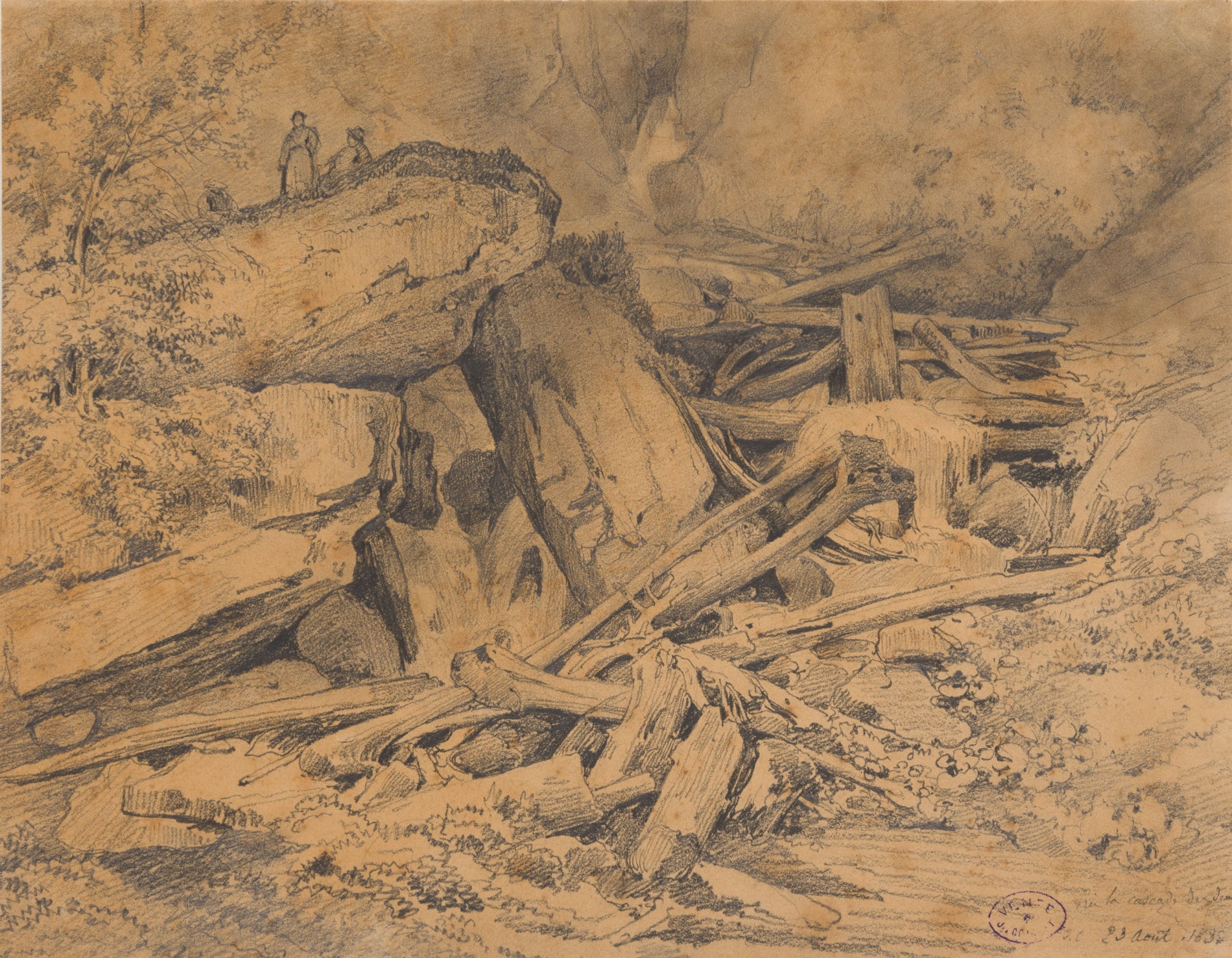Jules COIGNET
(Paris 1798 - Paris 1860)
Figures in a Landscape by a Waterfall
Pencil on buff paper.
Signed with initials, dated and inscribed Près la cascade de danio(?) / JC 23 Aout. 1832 in pencil at the lower right.
Stamped with the Coignet vente stamp (Lugt 451c) at the lower right.
244 x 314 mm. (9 5/8 x 12 3/8 in.)
Signed with initials, dated and inscribed Près la cascade de danio(?) / JC 23 Aout. 1832 in pencil at the lower right.
Stamped with the Coignet vente stamp (Lugt 451c) at the lower right.
244 x 314 mm. (9 5/8 x 12 3/8 in.)
Drawn on the 23rd of August 1832, the present sheet is typical of Jules Coignet’s careful pencil studies of particular landscape details and motifs, some of which were used for his book. A large number of pencil drawings of this type are today in the collection of the Musée d’Art Roger-Quilliot in Clermont-Ferrand.
A landscape painter, draughtsman and lithographer, Jules-Louis-Philippe Coignet was, like Camille Corot, Achille-Etna Michallon and Camille Roqueplan, a pupil of the classical landscape painter Jean-Victor Bertin. He competed for the Prix de Rome in 1821, in the category of historical landscape, but soon began working on topographical views, based on drawings and oil sketches executed on his frequent travels. He was a regular exhibitor at the Paris Salons between 1824 and 1857, winning a gold medal on his debut for a now-lost View of the Gulf of Salerno. Coignet visited Italy at least twice, once in the 1820s when he remained for several years, and then again in the 1840s, when he may have been on his way to the Holy Land. While in the early part of his career Coignet painted views of Rome, Sicily and Switzerland, from the late 1830s he worked mainly in France, and in particular in Brittany and Normandy, as well as at the forest of Fontainebleau.
Coignet was a splendid colourist, sensitive to the effects of light and atmosphere in the views he depicted. Unlike some of his contemporaries, who constructed their landscapes by combining different motifs into a unified painted composition, he preferred to draw and paint fully-fledged views. As a contemporary French writer noted of the artist, ‘Coignet did not like to compose his landscapes, because nature does not need, he said, that one lends it a grandeur or a charm of which it is itself the inexhaustible source, but he professed that one must attach oneself, by reproducing it in some way, to present a character worthy of fixing the attention or interest.’ Coignet published a guide to landscape painting, entitled Cours complet de paysage, in 1833, and his studio soon drew numerous young artists attracted by his naturalistic style of landscape painting. He developed a reputation as an inspirational teacher, counting among his students François-Auguste Ravier and Charles-Théodore Frère. Coignet also produced lithographs of landscape subjects, including sixty views of Italy published in 1825 as Vues pittoresques de l’Italie, dessinées d’après nature.
A prolific draughtsman, Coignet was much admired in his day. The Welsh writer and journalist Henry Longueville Jones, who lived in Paris between 1834 and 1842, described Coignet as ‘an artist of great reputation and success, who can command a host of pupils and followers, and who is not unworthy of his fame. His chief qualification is that of admirable drawing: there is, perhaps, not such a landscape draughtsman in France; and his intimate acquaintance with, and observance of Nature in all her forms, confer on him a great advantage: there is no one who can draw a tree better than Coignet…’
Coignet was a splendid colourist, sensitive to the effects of light and atmosphere in the views he depicted. Unlike some of his contemporaries, who constructed their landscapes by combining different motifs into a unified painted composition, he preferred to draw and paint fully-fledged views. As a contemporary French writer noted of the artist, ‘Coignet did not like to compose his landscapes, because nature does not need, he said, that one lends it a grandeur or a charm of which it is itself the inexhaustible source, but he professed that one must attach oneself, by reproducing it in some way, to present a character worthy of fixing the attention or interest.’ Coignet published a guide to landscape painting, entitled Cours complet de paysage, in 1833, and his studio soon drew numerous young artists attracted by his naturalistic style of landscape painting. He developed a reputation as an inspirational teacher, counting among his students François-Auguste Ravier and Charles-Théodore Frère. Coignet also produced lithographs of landscape subjects, including sixty views of Italy published in 1825 as Vues pittoresques de l’Italie, dessinées d’après nature.
A prolific draughtsman, Coignet was much admired in his day. The Welsh writer and journalist Henry Longueville Jones, who lived in Paris between 1834 and 1842, described Coignet as ‘an artist of great reputation and success, who can command a host of pupils and followers, and who is not unworthy of his fame. His chief qualification is that of admirable drawing: there is, perhaps, not such a landscape draughtsman in France; and his intimate acquaintance with, and observance of Nature in all her forms, confer on him a great advantage: there is no one who can draw a tree better than Coignet…’
Provenance
The studio of the artist, Paris
The vente Coignet (‘Tableaux et études peintes, pastels, aquarelles, sépias, dessins & croquis, laissés par M. Jules Coignet’), Paris, Hôtel Drouot [Escribe], 8-12 April 1861 [lot unidentified].
The vente Coignet (‘Tableaux et études peintes, pastels, aquarelles, sépias, dessins & croquis, laissés par M. Jules Coignet’), Paris, Hôtel Drouot [Escribe], 8-12 April 1861 [lot unidentified].




